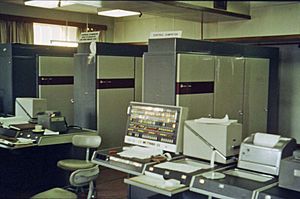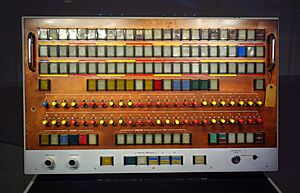Atlas (computer) facts for kids

The University of Manchester Atlas in January 1963
|
|
| Product family | Manchester computers |
|---|---|
| Release date | 1962 |
| Units sold | 3 (+ 3 Atlas 2) |
The Atlas was one of the world's first supercomputers. It was used from 1962 to 1972. When it first came out, many people said it was the most powerful computer in the world. Some even joked that when Atlas stopped working, half of the UK's computer power was gone!
Atlas was special because it was the first computer to use something called virtual memory. This is like having a super-smart way to manage computer memory. It uses a technique called "paging," which helps the computer run many programs at once. This idea was so good that almost all computers today use it.
Atlas was a "second-generation" computer. This means it used transistors instead of older, bigger vacuum tubes. It was built by a team from the University of Manchester, working with two companies, Ferranti and Plessey. Two other Atlas computers were also built. One went to BP and the University of London. The other went to the Atlas Computer Laboratory near Oxford.
A slightly different version, called the Titan or Atlas 2, was made for the University of Cambridge. It had a different way of organizing its memory. It also used a special operating system that let many users share the computer at the same time. Two more Atlas 2 machines were delivered. One went to the CAD Centre in Cambridge. The other went to the Atomic Weapons Research Establishment.
The Atlas computer at the University of Manchester was turned off in 1971. The very last Atlas computer, the one at the CADCentre, was switched off in late 1976. Some parts of the Chilton Atlas are now kept by National Museums Scotland in Edinburgh. The main control console was found again in 2014. It is now at the Rutherford Appleton Laboratory near Oxford.
Contents
How Atlas Was Created
Why a New Computer Was Needed
In the mid-1950s, people in the UK realized they were falling behind the US in computer development. Computers in the UK were slower than the fastest ones in America. Tom Kilburn and his team at the University of Manchester were already working with new transistors. These were much smaller and faster than older computer parts.
Kilburn asked potential users what they wanted in a new computer. Businesses wanted to connect many different devices to the computer. The Atomic Energy Authority wanted a computer that could do one million instructions per second. This led to the project being called MUSE, which stood for "microsecond engine."
It's tricky to make a computer that can handle many devices and also be super fast. Imagine a computer waiting for a slow card reader! To solve this, the new system needed extra memory to hold data. It also needed an operating system to manage everything.
From MUSE to Atlas
The idea for a faster computer caught the attention of the National Research Development Corporation (NRDC). This group helped move new technologies from research labs to the market. They held many meetings with companies and design teams.
Even with all this effort, there was no money from the NRDC by 1958. So, Kilburn decided to build a smaller MUSE first. This was paid for by money earned from renting out time on the University's older Mark 1 computer. Soon after, in October 1958, Ferranti decided to join the project. In May 1959, they received a grant to build the full system. At some point, the machine was renamed Atlas.
The detailed plans for Atlas were finished by the end of 1959. Work on the compilers (programs that translate code) was going well. However, the "Supervisor" operating system was behind schedule. David Howarth, a new hire at Ferranti, helped expand the operating system team. They worked very hard to create the Supervisor. It had 35,000 lines of assembler language code. This system could run many programs at once, which helped with handling all the different devices.
Where Atlas Computers Were Used
The first Atlas computer was built at the University of Manchester in 1962. It was officially started on December 7, 1962. At first, it had an early version of the Supervisor and only one compiler for Autocode. By January 1964, the final Supervisor was installed. It also had compilers for ALGOL 60 and Fortran.
By the mid-1960s, the Manchester Atlas was used almost constantly. It ran for 20 hours a day. During that time, it might run as many as 1,000 programs! The University and Ferranti shared the computer's time. Ferranti charged its customers £500 an hour. The Manchester Atlas was turned off on November 30, 1971.
Ferranti sold two more Atlas computers. One went to a group from the University of London and BP in 1963. Another went to the Atomic Energy Research Establishment in December 1964. This last machine was later moved to the Atlas Computer Laboratory. This made it easier for more people to use. This Atlas became the largest one. It had a lot of memory and many tape drives. Universities across the UK could use its time. It was shut down in March 1974.
Titan and Atlas 2 Computers
In February 1962, Ferranti gave some Atlas parts to the University of Cambridge. In return, the University would use these parts to make a cheaper version. This led to the Titan machine, which started working in the summer of 1963. Ferranti sold two more of this design as Atlas 2. One went to the Atomic Weapons Research Establishment in 1963. The other went to the government's Computer Aided Design Center in 1966.
Atlas's Impact on Computing
Atlas was designed to compete with powerful US computers like LARC and STRETCH. Atlas was much faster than LARC. It was only slightly slower than STRETCH. In 1962, the head of Ferranti's software team said Atlas was the "world's most powerful computing system." He believed Atlas would finish any set of computing jobs faster than other computers.
It wasn't until 1964, when the CDC 6600 arrived, that Atlas was truly beaten in speed. CDC later said that a description of the early MUSE project gave them ideas. These ideas helped them build the 6600 faster than planned.
Ferranti faced money problems in the early 1960s. So, they sold their computer division to International Computers and Tabulators (ICT) in 1963. ICT decided to focus on mid-range computers.
Many people in the computer industry thought highly of Atlas. C. Gordon Bell of Digital Equipment Corporation praised it. He said Atlas showed many good design ideas. It could run multiple programs at once. It had a large memory space. It also introduced the idea of "extra codes" to add more functions to its instructions.
In June 2022, the Atlas Computer and its invention of virtual memory were recognized as an IEEE Milestone. This is a special award for important achievements in electrical engineering and computing.
How Atlas Was Designed
Computer Parts and Features
Atlas had many new and smart features. Here are some key details about how it worked:
- It used a 48-bit word size. A "word" is a group of bits that the computer processes together.
- It had a very fast adder. This part of the computer does math quickly.
- It had a large address space of 2 million words. This is like having a huge number of mailboxes for data.
- It had 16,000 words of fast core store. This is like the computer's main working memory.
- It also had 8,000 words of read-only memory (ROM). This "fixed store" held important programs like the Supervisor.
- It used 96,000 words of drum store. This was slower but held more data. It worked with the core store using virtual memory.
- Atlas had 128 high-speed index registers. These helped the computer quickly find and change memory addresses.
- It could connect to new peripherals, like magnetic tape drives. It also had direct memory access (DMA). This allowed devices to send data directly to memory without bothering the main processor.
- Atlas used an associative memory. This helped it quickly find if a piece of virtual memory was in the fast core store.
- It used instruction pipelining. This means it could work on different parts of several instructions at the same time, making it faster.
Atlas did not use a regular clock like most computers today. It was an "asynchronous processor." This means its parts worked at their own speed. Here are some examples of how fast it was:
- Adding two fixed numbers: 1.59 microseconds (a microsecond is one millionth of a second).
- Adding two floating-point numbers: 1.61 microseconds.
- Multiplying two floating-point numbers: 4.97 microseconds.
Extracode: Special Instructions
One unique feature of Atlas was "Extracode." This was a clever way to add complex instructions using software. The computer had special hardware to quickly start and finish these extracode routines. The code for these routines was stored in the fast ROM.
The first ten bits of an Atlas instruction told the computer what to do. If the first bit was zero, it was a normal instruction. If it was one, it was an Extracode. This would make the computer jump to a special program in the ROM. There were about 250 extracodes.
Extracodes are similar to what we call software interrupts or traps today. They were used for math problems that would be too slow to do with just hardware, like finding the sine or square root of a number. About half of the extracodes were for Supervisor functions. These called on the operating system to do things. For example, "Print this character" or "Read a block of data from tape." Extracodes were the only way a program could talk to the Supervisor.
Atlas's Software Innovations
Atlas was a pioneer in many software ideas that are still used today. Its Atlas Supervisor is often called the first truly modern operating system.
One of the first high-level languages on Atlas was Atlas Autocode. This was created to fix some issues with another language called Algol 60. However, Atlas also supported Algol 60, Fortran, and COBOL. It also had ABL (Atlas Basic Language), which was a simpler language close to the computer's own machine language. Students at the university could use the computer to write programs in a safe environment.
Many of the compilers for Atlas were written using the "Brooker Morris Compiler Compiler (BMCC)." This was one of the first programs that could help create other compilers.
Atlas also had a programming language called SPG (System Program Generator). An SPG program could even write more code for itself while it was running! It could also define and use macros.
From the very beginning, Atlas was designed to be a supercomputer with a complete operating system. The hardware had special features to help the operating system work well. For example, extracode routines and interrupt routines had their own dedicated memory and registers. This made it very fast to switch between different modes of operation.
See also
 In Spanish: Atlas (computadora) para niños
In Spanish: Atlas (computadora) para niños
- Manchester computers
- Atlas Supervisor
- History of supercomputing


